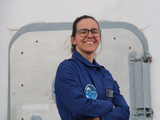Delano’s Heliophysics ROSES-24 Proposal Awarded Funding
Kevin Delano’s proposal “Generation and transport of nitric oxide during geomagnetic storms”, submitted to the NASA ROSES-24 Heliophysics Supporting Research (HSR) Program, has been selected for...
Posted: March 26, 2025, 5:28 PM

Crew Commander Ariadna Farrés completes Hypatia II mission!
Ariadna Farrés, Assistant Research Scientist with GPHI/UMBC, served as Crew Commander of the Hypatia II mission, which occurred February 2 - 15, 2025. "Hypatia Mars is a female-led organization...
Posted: February 26, 2025, 2:30 PM

Learn about Sun Spots and Solar Flares with NASA's Illuminate Series
The recent viewing of the Aurora Borealis on October 10 and 11, 2024, resulted in spectacular photos from across the globe, including locations that usually would be too far away to view the...
Posted: November 5, 2024, 12:34 PM

GPHI Scientist participated in Early Career Scientist Forum 2024
On Wednesday, October 23, 2024, the Early Career Scientist Forum (ECSF) 2024 was held in person in Building 34, Rooms W150 and W120 at NASA Goddard Space Flight Center. Scientists presented on “a...
Posted: October 28, 2024, 4:07 PM

Farres-Basiana profiled in Conversations with Goddard
Ariadna Farres-Basiana (UMBC) was recently profiled in a Q&A in Conversations with Goddard titled "There Are No Imaginary Boundaries for Dr. Ariadna Farrés-Basiana." Dr. Farres-Basiana is an...
Posted: August 5, 2024, 12:35 PM

- Go to page 1
- Go to page 2
- Go to page 3
- Go to page 4